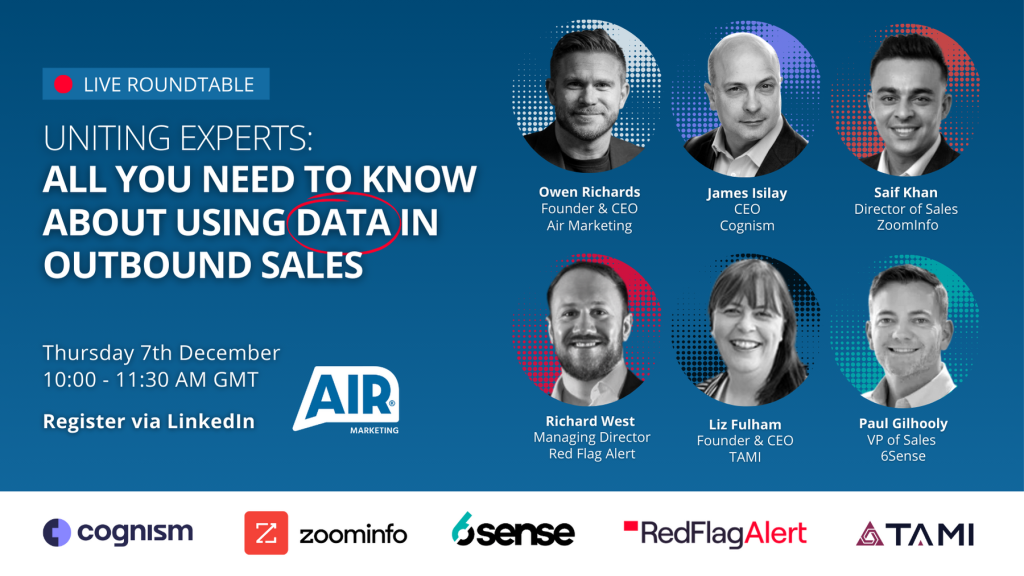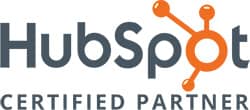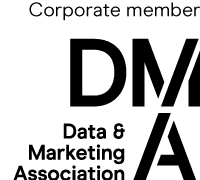At the close of last year, our exclusive roundtable, hailed by viewers as ‘the event of the year’ and one of our most successful yet, brought together the leading minds from all major data providers in the industry to discuss everything you need to know about using data in outbound sales. Offering key insights across strategy, intent data, data accuracy and the best practices for utilising data – it’s an absolute must-watch for anybody involved in the sales process.
Hosted by Air’s Founder & CEO, Owen Richards, our expert panel featured:
- James Isilay – CEO at Cognism
- Saif Khan – Director of Sales at ZoomInfo
- Liz Fulham – Founder & CEO at TAMI
- Paul Gilhooly – VP of Sales at 6sense
Here, their insights are revealed:
Everything Starts with Your ICP
“Many clients don’t know what their TAM (Total Addressable Market) is” says Liz Fulham. One of the common pitfalls of outbound sales is the spray and pray approach.
Ringing everyone on a list with no process or targeting strategy in place is what Paul Gilhooly calls a sure “revenue and productivity killer.”
The best way to lift your revenue line is to know who to target, what their pain points are and “how your solution fits into your prospect’s organisation” as Saif Khan offers.
Have an Efficient Operating Model
The importance of having a clear and efficient operating model within sales cannot be overstated. After all, data and outbound go hand in hand. A good operating model will tie into that strategy and allow you to maximise your data for success. Paul Gilhooly informed us that 5-10% of your TAM will be in-market at any given moment. Ensuring that you have a process of capturing those accounts will help you to prioritise the most important accounts that are in-market for your solution. As he is says “In this economy, missing out on opportunities is the worst, so if you don’t have a process for that you’re missing a trick.”
Saif echoes and elaborates on the importance of having the tools and a blueprint of how you’re going to reach your goals. “The two biggest things are alignment and resource allocation” he says. With everyone in the team being asked to do more with less these days, it’s important that sales and marketing teams communicate and that you are providing for the accounts that have the highest yield. It’s not enough to focus on the leads generated at the top of the funnel anymore, so leveraging data from all departments to inform how you approach sales is fundamental.
Using Data Effectively
Many companies come to data providers with the goal of enhancing their revenue but think they need to “rip and replace” all the data they have collected so far. Saif says it’s actually all about assimilating what has worked up until now and leveraging the right solutions to understand where the volume and quality of leads can be improved. When you understand the bigger picture, you can build short- and long-term plans for your success.
AI
AI is changing the world. It has so many uses within outbound sales such as helping SDRs to create ICPs based on their best-selling customers. Paul Gilhooly also explains how within 6sense’s platform it can be used to do a statistical lookback at the last few years of your CRM data and identify key trends and opportunities.
AI can be instrumental in getting the timing of outreach right, as well as providing a workflow to help you to prioritise the best opportunities. Liz explains that “using AI we’re able to match the data in the CRM to bring it right up to date with what’s happening on the internet.” In fact, it’s so powerful that it can update a changed job role from LinkedIn within minutes. This is amazing for reducing duplication and data accuracy.
Intent Data
Intent data is all about understanding the dynamic of how people buy today. Paul offers up two key questions here:
- Do we want to contact the people who we could sell to?
- Or do we want to contact people who want to buy?
From there you can ascertain what sales opportunities there are and if they are really feasible.
With first- and third-party data to consider as well as anonymous data there is lots to consider and much research emerging too. Rather than looking at one subset of data, it’s important that you aggregate it to get a full picture of your ICP’s pain points, needs and buyer readiness.
Outbound Sales Best Practices
- Opt for Account-Based selling over transactional selling
- Take a multi-channel approach – don’t just sell through the phone
- More doesn’t mean more, its quality that counts
- Personalisation, relevance and timing have never been more important
- Leverage what you already have alongside intelligence tools
- Offer a bespoke, tailored approach at every stage of the sales cycle
- Profile the right companies to call using the data
- Work on accounts that align to who the AE is going to sell to
- Know your sales hooks
- Be intentional with how you use data
- Always A/B test
- Ask the right questions
- Be patient
It’s pays to remember that there is no one size fits all when it comes to sales and marketing intelligence. James Isilay summarised it well when he said “data providers are a bit like newspapers. We all have different ways of collecting data and different propriety signals that we overly on that. There’s always differences in our data and accuracies. We all make a different soup in how we bring the data together.”
The most important thing is that you engage influencers and decision makers within a company in the right conversations, demonstrating that you understand their challenges and have a specific solution to ease them.
Outbound sales should be a collaborative approach laser-focused around your prospects. Making effective use of data at every stage of the sales process is vital especially within the mid to end of the funnel where there is so much intelligence to be gleaned.
As James says “Don’t burn the opportunities that you do get. They’re so hard to come by right now – they’re like golden nuggets!”
Thank you to our excellent panel for their time and knowledge. We hope that you found this roundtable as engaging and insightful as we did!






